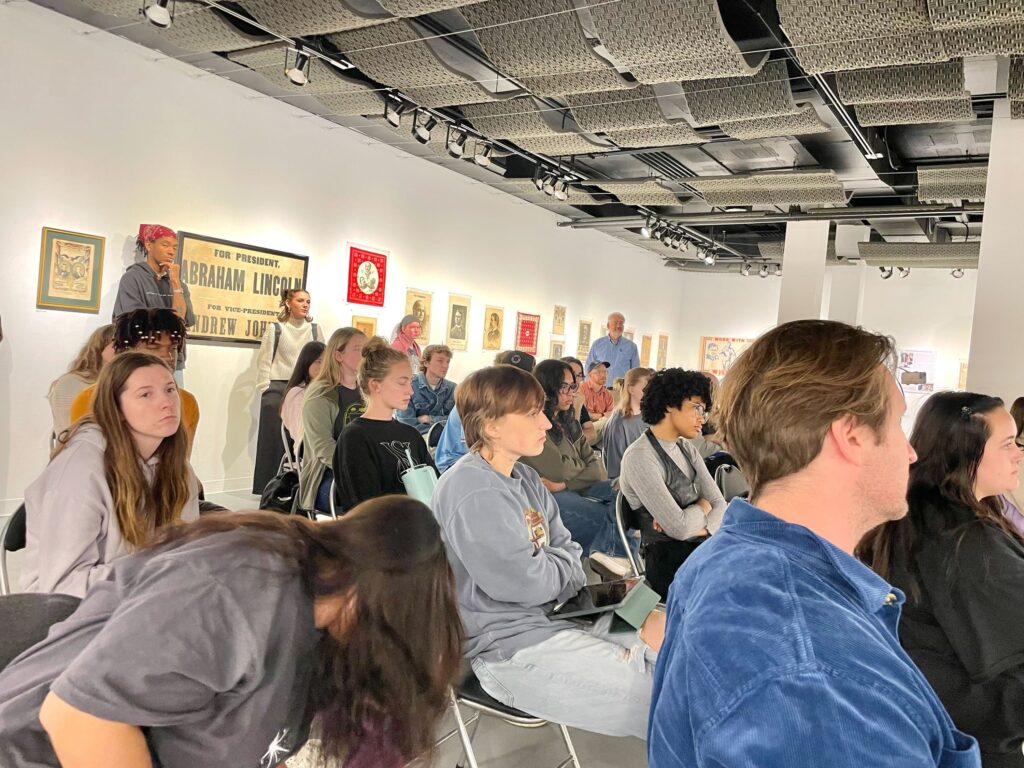Feature photo by Abby Barber
Story by Bailey Lowe and Lillian Chapman
Election Day at MTSU began quietly, but it didn’t take long for campus to start bustling. Political dialogue spanned from the Honors College to the Todd Art Building, and in the Student Union, SGA and other campus organizations were gearing up for the campus-wide election watch party.
The Murfreesboro Election Protection Hub, a joint effort between the Equity Alliance, Organize TN, Civic TN and the Tennessee Immigrant and Refugee Rights Coalition (TIRRC), was a lively scene early on Tuesday, while volunteers called, texted and wrote postcards thanking citizens for participating in the democratic process. The group congregated in room 106 of the Honors College, facilitated through the American Democracy Project, with donuts, coffee and other snacks.
In addition to voter outreach, in the back corner of the auditorium, Miura Rempis-Locke was typing away on her laptop.
Rempis-Locke works as a member of the 866 Voter Protection Hub Hotline helping solve election-related problems across the state. Unlike the volunteers helping with the postcards, she needed election day credentials due to the nature of her work.
“I can actually see all of the voter concerns that are happening across the state,” Rempis-Locke said.
When facing a problem, poll watchers can call the hotline. The hub contacts the local election commission involved in order to resolve issues that voters call in.
She mentioned a situation earlier today, where a student from Bethel University was turned away from the polls. She moved from another state, and she only had a paper version of her Tennessee driver’s license. After calling the Carroll County Election Commission, the student was able to vote.
“This is all federally protected, so if they did not give her [a provisional ballot], it would be a violation of election law,” Rempis-Locke said.
Across campus in the Todd Art Gallery, students and teachers gathered for the lecture Designed to Win on the importance of graphic design in politics on Election Day, filling every chair.
The Albert Gore Research Center hosted Jennifer Gagliardi, an art professor in graphic design history at MTSU, who discussed how political campaigns and graphic design evokes emotion and affects the public opinion of politicians. Memorabilia of political campaigns from memorable elections lined the walls, demonstrating how graphic design inspired individuals to feel confident in their votes.
Gagliardi presented campaign posters from the 1800’s to highlight how poster designs emphasized trust and stability in candidates. Oftentimes, campaign posters were the only way voters saw the faces of political candidates.

“The campaign poster is not used to sway one way or another,” Gagliardi said. “[It’s] more as a tool to rally the troops.”
Posters provided information to the public; however, today with the popularity of social media, election campaigning has moved online.
“Posters are replaced by social media campaigns,” Gagliardi said. “The fact that politicians think they need a TikTok or social media performance and face to get an audience has steered away from the use of print posters and graphic design.”
While establishing an online presence has become the norm, posters are still used as a rallying cry for people who already support a specific candidate. Posters are more abstract and artistic, using specific techniques like letterpress and printing.
As the day came to a close, a stage and four TVs dominated the Student Union atrium in preparation for the SGA election night watch party.
Bailey Lowe and Lillian Chapman are contributing writers for MTSU Sidelines.
To contact the News Editor, email newseditor@mtsusidelines.com. For more news, visit www.mtsusidelines.com, and follow us on Facebook at MTSU Sidelines and on X and Instagram at @mtsusidelines. Also, sign up for our weekly newsletter here.

